skip to main |
skip to sidebar
I've had my eye on a tomato chutney recipe that Hema of Vegetarian Concoctions posted on her blog back in February. I’m assuming it was a variation on her own Chettinadu tomato chutney, but really it’s her friend Ranjini’s recipe. (Thanks, ladies!)
I’ve been meaning to make it ever since (how many times do you think I might have said this over the years?) – and now, only a couple of months later, here I am, posting about my attempt at making the chutney!
The ingredients are pretty much the same, only the proportions are somewhat different, because I made a larger quantity than specified in the recipe (me being forced to use up some tomatoes that were getting suspiciously soft – and how many times have you heard THAT from me about some vegetable or other?). Oh okay, I also substituted a couple of ingredients…
It’s a pretty good chutney and keeps well for a day or so. Probably would live a bit longer in the fridge, but I didn’t bother with that.
I had it with dosas made with the muthu samba rice that I nearly threw out...
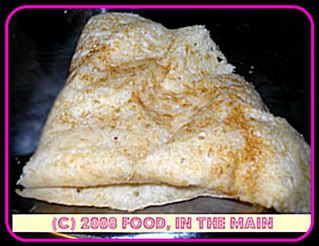
but I’m glad I didn’t, because now I can send this post off to Srivalli’s Dosa Mela in the happy aftermath of my samba experiment!
Recipe for: Chettinadu tomato chutney
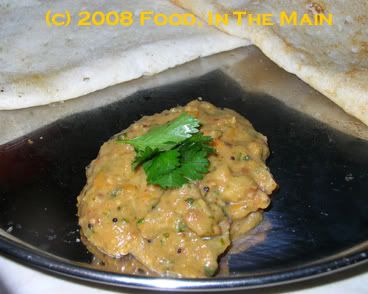
Ingredients:
2 medium onions, chopped
5-6 small tomatoes, chopped
½” piece ginger, chopped or sliced
2 tbsp chana dal
1 tbsp urad dal
¼ tsp fenugreek seeds
Turmeric – a pinch
1 tbsp chopped coriander
1 tbsp mint leaves, chopped
4 dried red chillies (or to taste)
Pinch of asafoetida powder (optional)
1 tbsp and 1 tsp oil
Salt to taste
1 tsp mustard seeds
A few fresh curry leaves, torn in half
Method:
1. Heat 1 tbsp of oil, and red chillies, urad dal, chana dal, fenugreek seeds and asafoetida powder.

2. Stir till the dals turn golden brown,
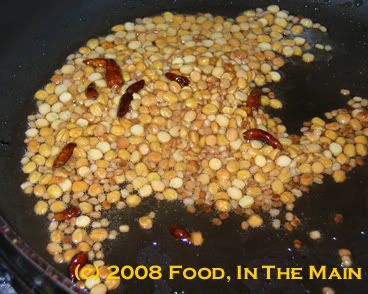
then add onion and cook till soft and translucent.
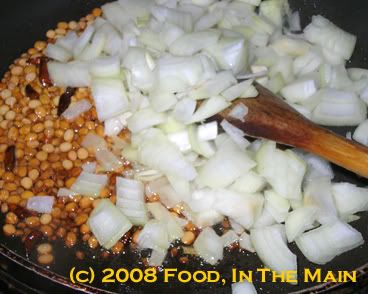
3. Then add the chopped tomatoes, ginger and turmeric powder and cook till the tomatoes turn mushy.
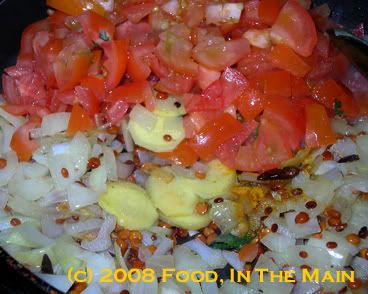
4. Add the mint and coriander leaves and stir them in.
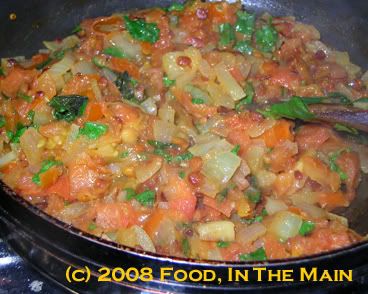
Cook for a minute or two, then turn the heat off.

5. Once the mixture is cool, grind it to a fairly smooth paste (with maybe 2-3 tbsp of water if required) and mix in salt to taste.
6. Heat the remaining tsp of oil in a small pan. Put in the mustard seeds and curry leaves, cover and let the seeds pop.
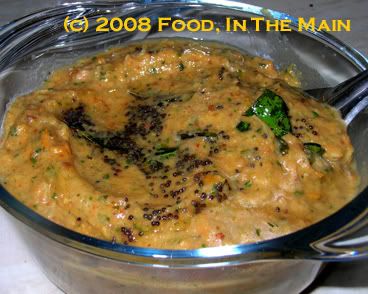
7. Pour this tempering over the tomato chutney and serve with dosa, idli, chapati, etc.
There's a classic accompaniment to vattha kuzhambu that my mother used to make for my dad, years and years ago, when we lived in Tanzania. It's called "paruppu thogayal", a bland (in the sense of no chillies being added) chutney made of roasted tur dal. Since vattha kuzhambu isnt made with the addition of cooked tur dal, this chutney was a way of adding protein to the meal. I dont remember if I loved the chutney as much as my dad, but since my mother hasnt made it in years (since Tanzania, if memory serves me right), we kids cant have been that fond of it.
Anyway, I've never made it before nor seen how it was made, so I didnt quite know the method. I was looking for recipes using tur dal for Linda's JFI Tur Dal event when I came across a "tur dal thuvayal" recipe on the Net - I think it was on the ForumHub site, but for the life of me I cant find that chat link again!

Top: Moong dal; Bottom: Tur Dal
Anyway, apart from the main item, Tur Dal, it called for red chillies, raw garlic and some moong dal - these three ingredients completely threw me off the scent, as it were. I didnt think it was a variation of the paruppu thogayal my mother used to make... until it came to grinding the roasted dal. Then the aroma instantly made itself the familiar yet long-forgotten one of paruppu thogayal.
Since I used raw garlic, red chillies and moong dal to make this chutney, it wasnt quite my mother's version. Call it a grown-up version, if you will. I cant say that I fell in love with this version any more than I did with the original... but it wasnt bad either. It's just that the roasted tur dal flavour is VERY intense. Of course this is only my personal opinion of the chutney... chances are there are people who slaver just at the thought of it! So here it is, my entry for JFI - Tur Dal.
Recipe for: Tur dal chutney
1 tsp payatham paruppu (moong dal)
1/4 cup thuvaram paruppu (tur dal)
5-6 dried red chillies (or to taste)
3 garlic pearls
1/2 tsp oil
salt to taste
Water as required
Method:
1. Heat the oil and fry the dals and red chillies separately over a medium flame, stirring constantly.
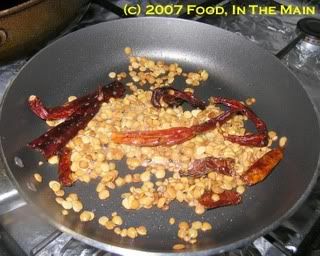
The dals should be golden brown (take care not to burn them) and the red chillies should turn darker in colour. Let cool completely.
2. Grind the fried dals, chillies, garlic with 4-5 tablespoons of water to a smooth paste.

Dont worry about adding more water - the chutney solidifies quite a bit after grinding as it absorbs the water.
3. Add salt to taste and mix well. This can be served with rice and ghee or as a side with dosas or idlis.
It's been so long since I've posted a recipe on here, and I was feeling so reluctant to move my a** after a hugely long travel blog that I decided the only to ease myself back into the food blog world was to post a simple recipe. Preferably from someone other than me. That someone, of course, is my Kiwindian friend, KiwiGee, and the star of the recipe is the groundnut.
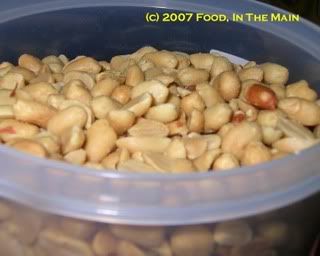
This recipe has been languishing in my "recipes to make" folder for ages, mainly because I was not able to get my hands on copra (dry coconut). On being informed that desiccated coconut would do just as well, I bought a bagful - only, of course, to have two holidays come up in quick succession with not much time in between for anything much except to write a Slavonian food-logue.
And now, since no more holidays seem to be in the offing this year, I have no more excuses to put off writing food posts! So here goes.
In her email to me, KiwiGee said: "This recipe is a variation of the traditional thengai podi (for Tamilians) and chutney podi (for Kannadigas). I learnt the original chutney podi from my MIL and the variation is from sister Gayathri in NZ. I tend to use quite a few peanuts in my cooking nowadays as I keep exploring more and more avenues of vegetarian iron sources…"
So here it is, the perfect vegetarian iron source and a very scrummy powder to mix with plain rice and ghee.
Two things to note:
1. Powder the peanuts separately and do it in short bursts so as not to heat the motor of your mixie. Otherwise you'll end up with peanut butter. Which is nice enough, but not the result we're looking for here.
2. Be careful even while grinding the desiccated coconut - it also tends to exude oil and lump up if you run the mixie for too long and the coconut gets warm.
Recipe for: Groundnut chutney powder

Ingredients:
250 gms peanuts (I cheated a bit and used ready roasted peanuts)
50 gms dried red chillies (not Indian red – u’d die then, this is the mild sort that I get here* - in NZ)
50 gms copra (dried coconut, grated fine), or unsweetened desiccated coconut
Salt – to taste
Hing powder – a pinch
Jaggery (or sugar) – 1 tbsp
Tamarind - 1 tbsp (small ball) - NOT the paste!
Methi (fenugreek) seeds – 1 tsp
Method:
1. Dry fry methi seeds till they are dark brown, keep aside.
2. Dry fry peanuts (if using raw ones) till they go slightly brown, keep aside.
3. Then dry fry the copra/desiccated coconut powder, red chillies and tamarind and keep aside. (Note: I tore up the tamarind into small pieces so that they would fry more evenly) Let all the ingredients cool completely.
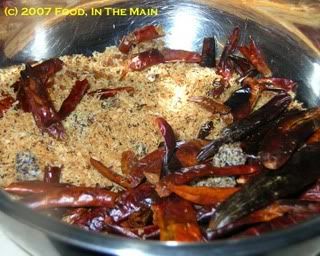
Important: All the ingredients have to be dry fried separately as indicated. This thing won’t work otherwise…
4. First, grind the red chillies, along with copra, tamarind and methi seeds as finely as you can.

This picture is at the half-way stage of grinding!
5. Then grind the fried peanuts to as smooth a powder as possible, after adding hing and salt.
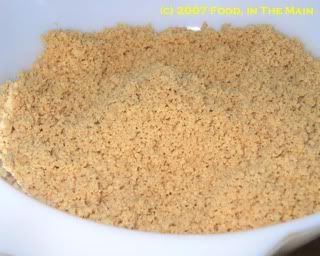
Beware: the peanuts are really oily so they can stuff up your food processor when you grind them. That’s why you need to grind them last, after all the other stuff has been reduced to powder…
6. Mix well and store in dry bottles/jars. DO NOT refrigerate.
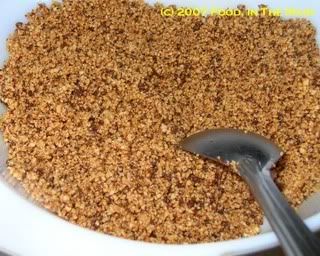
7. Serve with ghee and hot rice (yuM).
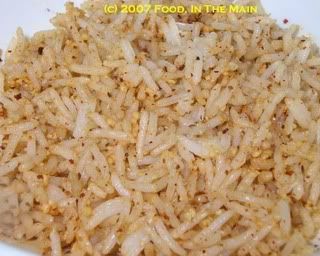
Can also be used as side dish for idli, dosa and with sandwiches etc…
Another day, another food event, another day of participation in another food event - yep, this here is my entry for "Think Spice - Think Seeds" hosted by Sunita of Sunita's World.
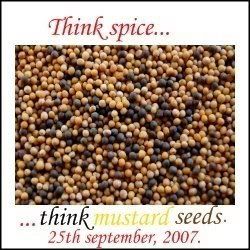
Not that it's anything extraordinarily out of the ordinary, because it isnt. I cant even be sure that I didnt read about a similar recipe somewhere else, sometime else... as far as I'm concerned, it was just a whim-of-the-moment to dry-roast and pound up some spices (which included mustard seeds) to make this tomato chutney. But what I CAN say is that it tastes different from the couple of recipes I posted on this blog in previous months. Different, but very nice. It's different to me in another way too, in that I usually cook the tomatoes down to a mush, and this time I didnt.
On a not entirely disconnected note, I bought a bottle of mustard oil a few months back, which I've been meaning to use... but I'm now looking for recipes which utilise it! If anyone has links or recipes, could they please point me in the right direction? I'd be MOST grateful...
Recipe for: Mustardy tomato chutney
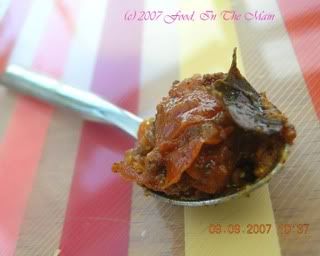
Ingredients:
1 tbsp mustard seeds
1/2 tsp cumin seeds
1 tsp coriander seeds
1/4 tsp fenugreek seeds
2 cups ripe tomatoes, chopped (not too fine)
2 tsp red chilli powder (or to taste)
a few curry leaves
pinch of asafoetida
3 tbsp oil
1/2 tsp mustard seeds
Salt to taste
1/4 cup water (use as required)
Method:
1. Toast the 2 tsp mustard seeds, cumin seeds, coriander seeds and fenugreek seeds over medium heat in a small pan, till they're aromatic and change colour. Keep shaking the pan so that the seeds dont burn.
2. Cool and pound to a powder with a mortar and pestle. Reserve.
3. Heat the oil in a pan. Add the asafoetida powder, curry leaves and 1/2 tsp mustard seeds, cover and let them pop.
4. Add the tomatoes and cook them over high heat until they start getting soft (2-3 minutes). Now add the spice powder and chilli powder stir it in.
5. Fry for another 3 minutes on high heat, stirring frequently. Pour about half of the water into the pan, stir, cover and reduce the heat to medium high.
6. Let the tomatoes cook for 5 minutes covered. The water should be nearly gone. Add salt to taste, stir again. If you like, you can add the remaining water at this point and cook the chutney for another 5 minutes, if you feel the tomatoes are not done enough.
7. Serve hot or cold with chapaties, dosas or rice.
This is a guest post of sorts, on behalf of one of my best friends - KiwiLax, she prefers to be known as - who lives in New Zealand. She doesnt have a food blog and believe you me, that is a definite loss to the world of food blogs. Gee (as I prefer to call her) has always been a wonderful cook, right from college days and, as I understand it, she has only become WAY better over the years. She's always been as much of a foodie as I - but somehow managed to keep the pounds off even while saying all the time that she "hogged like a pig".
Since Gee doesnt have the time to maintain a food blog (did I say that the blog world doesnt know what it's missing?), I suggested to her that perhaps she could email me her recipes for me to try out and then post on my blog. She thought it was a very good idea - but I guess the best ideas take the longest time to germinate (!), because it's been a while since I put forward my suggestion! I'm not grumbling, (not much, not really), but only because I know her time is taken up well and truly in looking after her two chlidren, holding down a full time job and doing a host of extra-curricular (read cultural) work.
So when she emailed me a hasty recipe for her justly famous tomato thokku, I was very pleased. Here's hoping that it doesnt take as much time for the next recipe!
Since I dont post recipes on here that I havent tried and tested, I made the tomato thokku exactly as per Gee's instructions. I only wish I could post the aroma of the thokku here along with the recipe! But you have to make it and see for yourself.
KiwiLax says: "This is a kind of variation of the traditional tomato thokku. Goes great with idlis, dosa, sandwiches, pongal, rotis and what not and is beautiful when mixed with plain rice or as a side with thayir sadam (curd rice)."
This thokku can be stored in the refrigerator for a month. It wont last that long, I'm sure.
Recipe for: Tomato thokku
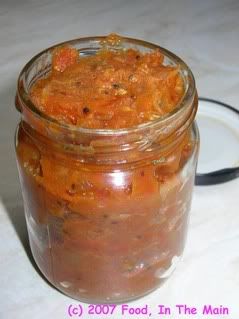
4 cups finely chopped fresh tomatoes (about 10 medium)
3 medium onions, chopped very fine
10-20 dried red chillies (or as per taste, depending on their heat)
6 tbsp gingelly oil (most preferred, but can use any regular cooking oil)
1 tsp methi (fenugreek) seeds
1 tsp mustard seeds
1 tsp urad dhal (ulutham paruppu)
1 tsp turmeric powder
1 tsp tamarind paste
1 tsp garlic, grated
salt to taste
Method:

1. Roast the dried red chillies and the fenugreek seeds in 1/2 tsp gingelly oil till the seeds turn dark and aromatic.

Set aside to cool, then grind to a fine powder.
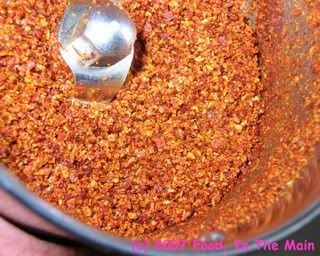
2. In a large, wide-bottom pan, heat the gingelly oil. Add the mustard seeds and urad dhal. Cover the pan and let the seeds pop (30 seconds).
3. Then add the onions and garlic. Stir well and fry for 3 minutes.
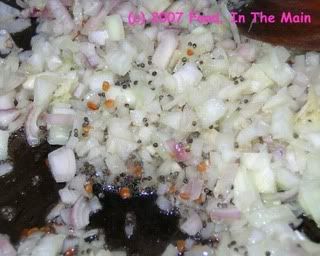
4. Now add the tamarind paste and turmeric powder and stir it in well.
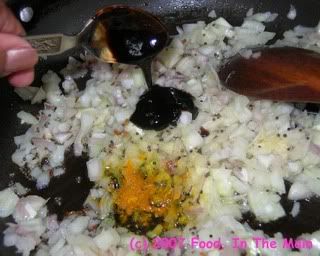
Let the onions fry on medium heat till they turn translucent and brown a little.
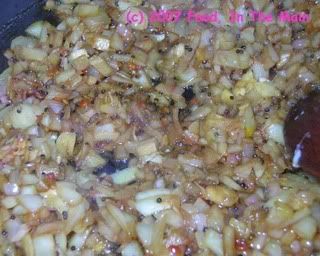
5. Add the chopped tomatoes now and cook, stirring occasionally, until the tomatoes start breaking down.
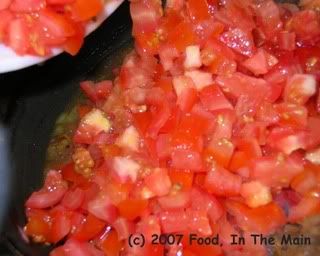
6. At this point stir in the chilli-methi powder prepared earlier, along with salt to taste. Add another 2 tbsp oil now if required.
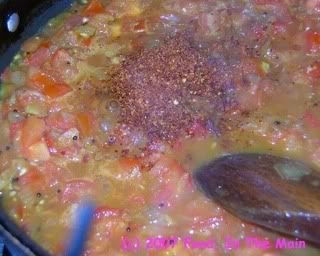
7. Let the tomatoes cook on medium high flame until they become a thick mass, with no moisture remaining. Oil should be separating around the edges.
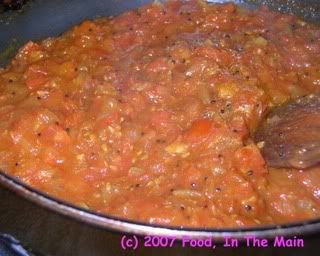
8. Let the thokku cool completely, then transfer to clean glass jars and store in the refrigerator.
































